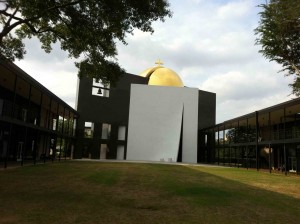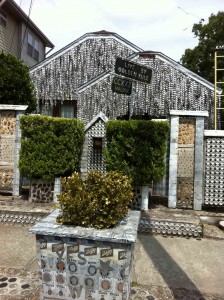
The Alley Theatre – a much-beloved Brutalist style building open since 1968 in downtown Houston. Photo courtesy Wikipedia.
Houston Musings
Can a city known for sprawl be a “True Green City”? I spent two days in Houston a couple of weeks ago and despite having no expectations of the “city with no zoning”, I found myself quite impressed and delighted. From someone who regularly sits in traffic for hours on the DC Beltway, the traffic on Houston’s highways-which my hosts were complaining about- seemed rather tame to me, even at rush hour.
I am no expert on Houston; I was only there for two very full days. But I was intrigued that a city which gets such a bad rap for sprawl has one of the highest collections of LEED certified projects (100 certified and hundreds more registered!) – both new and rehabs. I was also delighted that one of the key “brutalist” buildings downtown, the Alley Theatre built in 1968, continues to be lovingly used as a theatre, unlike my own city of DC where our brutalist heritage is constantly under attack.
From Iconic Modernism to Quirky Beer Cans
I gave a “Preservation month” talk for a combination of organizations including Houston Mod, USGBC Houston chapter, Greater Houston Preservation Alliance, AIA Houston and the Texas Chapter of APT. The event was held in a Philip Johnson designed university – the University of St. Thomas located in the Museum District. Surprisingly, Houston has one of the best collections of good Johnson architecture. And it was a treat to visit the university and even get to speak in the main public venue on campus. Johnson’s buildings can be found throughout the city, and I’d even say that outside of the Glass House, some of his best work can be found here.

The Chapel of St. Basil’s at the University of St. Thomas in the museum district of Houston, designed by Philip Johnson.
Yes, it was incredibly hot there (but no hotter than it currently is along the entire eastern half of the US) and everything is air conditioned. But I saw a lot of running paths along my tours, which were being heavily used. Houston has a light rail downtown, which has also gotten a bad rap, but it’s a start and there are plans to expand it. And while there is no actual zoning in the city it is interesting that many of the historic neighborhoods were designed by developers and architects who lovingly created their own “zoning” with the building types, roadways and parks they included in their developments.

The Houston Parks Department Headquarters, originally built in 1956 and used by NASA, was rehabilitated in 2009 and received LEED Gold certification.
I visited two rehab projects that represented the best of integrating green building practices into historic buildings – the Houston Central Building-Julia Ideson Building which is on target for LEED Silver and the recently completed Parks Department Headquarters which received LEED Gold. The former project includes the restoration of the historic building and an addition which complements the original design. The Park Headquarters is a 1956 modern, slightly Frank Lloyd Wright reminiscent one-story building previously used by NASA. Both owners are thrilled by their projects and thrilled that they are LEED projects. Everywhere I travel I see more and more historic buildings that are becoming LEED certified. The day that a LEED certified-historic building is no longer “news” will be a happy day for me and for both the historic preservation and sustainability fields. I look forward to the day in fact, where we don’t point out projects as historic preservation or sustainable – they should all just be good responsible architecture and good architecture projects.
There are the usual areas of concern – the battle to save the Astrodome being the most contentious right now. The Astrodome has been chosen to be part of the National Trust’s “This Place Matters” contest. And the old bungalow neighborhood surrounding the quirky “Beer Can” house has all but disappeared for contemporary townhouse developments.
So, what I learned from my two quick days in Houston is that I’d definitely like to go back and explore these topics and places more deeply. Houston has some fabulous architecture, from historic Spanish Revival such as the Central Library to a stellar collection of moderns including a museum addition by Mies van der Rohe, an entire university campus by Philip Johnson, a museum complex by Renzo Piano and a host of great, sound buildings designed by talented regional architects. A city that’s laughed at so often for its sprawl could as easily be admired for its authentic modern architecture which is used and preserved, its historic neighborhoods which offer some of the best in walkable communities despite the heat and a large metropolitan area filled with informed and active professionals who care about their city and climate change.
And if you’d like to “subscribe” or follow this blog, True Green Cities, please sign up through the “Subscribe” button at the bottom left of this page. You’ll receive a daily recap when new blogs are posted.

